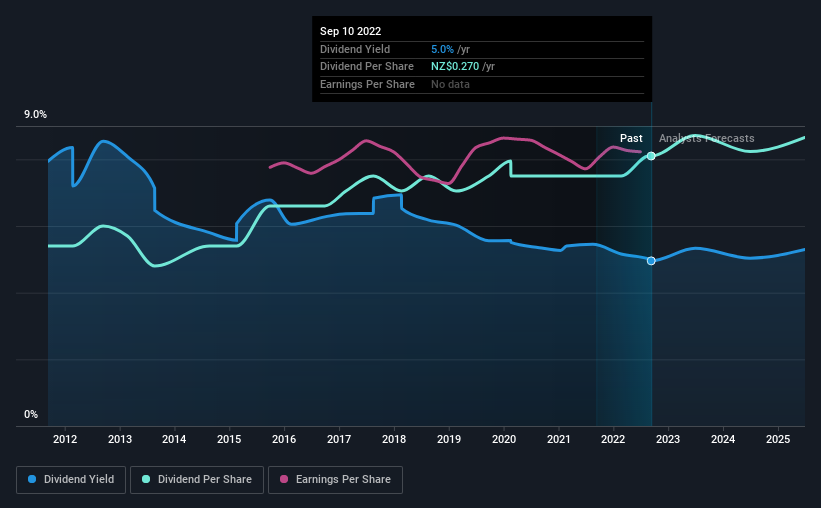Why It Might Not Make Sense To Buy Spark New Zealand Limited (NZSE:SPK) For Its Upcoming Dividend
Readers hoping to buy Spark New Zealand Limited (NZSE:SPK) for its dividend will need to make their move shortly, as the stock is about to trade ex-dividend. The ex-dividend date occurs one day before the record date which is the day on which shareholders need to be on the company's books in order to receive a dividend. The ex-dividend date is an important date to be aware of as any purchase of the stock made on or after this date might mean a late settlement that doesn't show on the record date. This means that investors who purchase Spark New Zealand's shares on or after the 15th of September will not receive the dividend, which will be paid on the 7th of October.
The company's next dividend payment will be NZ$0.15 per share, and in the last 12 months, the company paid a total of NZ$0.27 per share. Based on the last year's worth of payments, Spark New Zealand stock has a trailing yield of around 5.0% on the current share price of NZ$5.45. Dividends are a major contributor to investment returns for long term holders, but only if the dividend continues to be paid. So we need to check whether the dividend payments are covered, and if earnings are growing.
Check out our latest analysis for Spark New Zealand
Dividends are typically paid out of company income, so if a company pays out more than it earned, its dividend is usually at a higher risk of being cut. Spark New Zealand distributed an unsustainably high 114% of its profit as dividends to shareholders last year. Without more sustainable payment behaviour, the dividend looks precarious. Yet cash flows are even more important than profits for assessing a dividend, so we need to see if the company generated enough cash to pay its distribution. Spark New Zealand paid out more free cash flow than it generated - 110%, to be precise - last year, which we think is concerningly high. We're curious about why the company paid out more cash than it generated last year, since this can be one of the early signs that a dividend may be unsustainable.
Cash is slightly more important than profit from a dividend perspective, but given Spark New Zealand's payments were not well covered by either earnings or cash flow, we are concerned about the sustainability of this dividend.
Click here to see the company's payout ratio, plus analyst estimates of its future dividends.
Have Earnings And Dividends Been Growing?
Stocks with flat earnings can still be attractive dividend payers, but it is important to be more conservative with your approach and demand a greater margin for safety when it comes to dividend sustainability. If business enters a downturn and the dividend is cut, the company could see its value fall precipitously. It's not encouraging to see that Spark New Zealand's earnings are effectively flat over the past five years. It's better than seeing them drop, certainly, but over the long term, all of the best dividend stocks are able to meaningfully grow their earnings per share.
Many investors will assess a company's dividend performance by evaluating how much the dividend payments have changed over time. Spark New Zealand has delivered an average of 4.1% per year annual increase in its dividend, based on the past 10 years of dividend payments.
The Bottom Line
From a dividend perspective, should investors buy or avoid Spark New Zealand? Not only are earnings per share flat, but Spark New Zealand is paying out an uncomfortably high percentage of both its earnings and cashflow to shareholders as dividends. Bottom line: Spark New Zealand has some unfortunate characteristics that we think could lead to sub-optimal outcomes for dividend investors.
So if you're still interested in Spark New Zealand despite it's poor dividend qualities, you should be well informed on some of the risks facing this stock. Our analysis shows 3 warning signs for Spark New Zealand that we strongly recommend you have a look at before investing in the company.
Generally, we wouldn't recommend just buying the first dividend stock you see. Here's a curated list of interesting stocks that are strong dividend payers.
Have feedback on this article? Concerned about the content? Get in touch with us directly. Alternatively, email editorial-team (at) simplywallst.com.
This article by Simply Wall St is general in nature. We provide commentary based on historical data and analyst forecasts only using an unbiased methodology and our articles are not intended to be financial advice. It does not constitute a recommendation to buy or sell any stock, and does not take account of your objectives, or your financial situation. We aim to bring you long-term focused analysis driven by fundamental data. Note that our analysis may not factor in the latest price-sensitive company announcements or qualitative material. Simply Wall St has no position in any stocks mentioned.
Join A Paid User Research Session
You’ll receive a US$30 Amazon Gift card for 1 hour of your time while helping us build better investing tools for the individual investors like yourself. Sign up here

 Yahoo Finance
Yahoo Finance 
